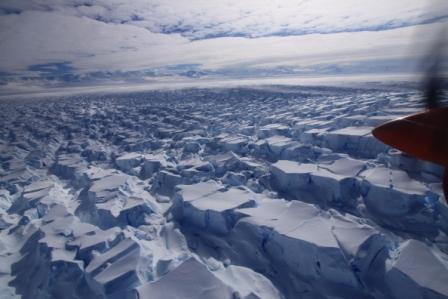Crevasses
We have a crevasse at the top of the ramp which has ropes allowing us to go for trips down inside of it and thru the cave system.
What this really drives home when you look up to the top of the cave and see the snow bridges is how careful you need to be when doing fieldwork. Crevasses are a constant threat on glaciers and are the greatest danger to field parties down here.
The movement of glaciers flowing downhill creates crevasses when the brittle surface layer (50-80m) is subject to forces such as change in angle or speed of flow. Glaciers in Antarctica are usually covered by several feet of snow making it difficult to see what is happening below the surface.

Crevasses tend to appear in similar places on any given glacier and can occur long distances downstream of the features that cause them. The causes of stresses on the brittle surface layer are:
1) Shape of slope – Convex slopes are more likely to be crevassed than concave slopes compression is a good thing and tension is a bad thing as it causes cracking.
2) Speed of flow
3) Glacier shape
4) Type of glacier
In areas where no crevasses are visible you will have to predict their likely position and orientation. Knowing the orientation of crevasses is as important as spotting where they are. The presence of crevassing is often marked by slumped snow bridges showing up as a faint linear depression.
So we learnt in field training how to rope up and use the necessary equipment to rescue someone from a crevasse. Crevasse bridges can be appreciably weaker in the late afternoon after the sun has warmed the snow. So during the summer travelling at night could be preferable at the end of the winter the bridges are obviously stronger due to maximum snow cover and lower temperatures.
4 Responses to “Crevasses”
-
Makes walking down Coleshill Road on a snowy day seem like childs play even tho A and E was filled the other day and the radio told about one girl who broke her rt wrist on day one and her left on day two! love mum
-
Egad!! Way cool, but going down into that ice seems scaarryy! What if it shifts while you are below?! A once in a lifetime view and experience for sure.
Fun blog. Keep it up. Sure beats the “news” and — well you know — on SA.
-
Your’e cracking me up!!! Love
DAD -
I own a cave in the Missouri Ozarks the cave stays a constant 59 F degrees. Do you by chance know the temperature of caves in Antartica any information would be appreciated. I have great interest in our natural world . I wish the best of luck down in the real down under.

